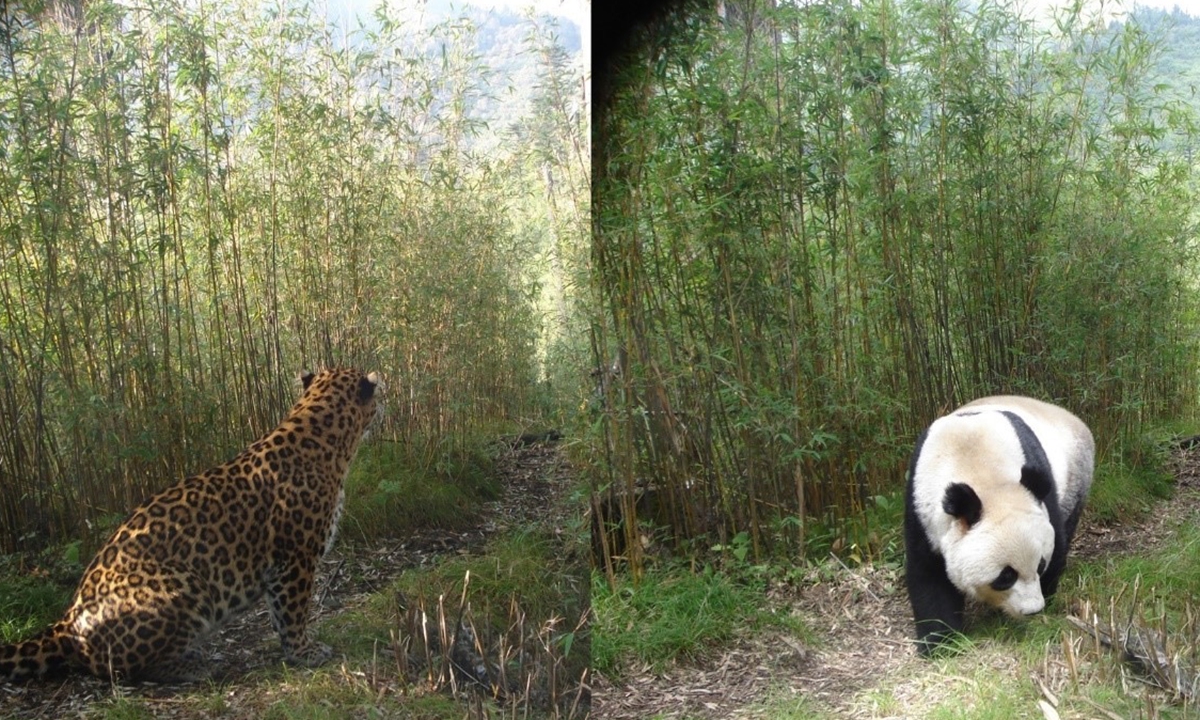Giant panda reservations play a significant role in protecting large predators
By Ji Yuqiao Source: Global Times Published: 2020/8/4 21:49:29

A leopard and a giant panda Photo: courtesy of Li Sheng
In an interview with the Global Times, Li Sheng, a researcher at Peking University who recently published a report on large carnivores in Nature Ecology & Evolution, took umbrage with AFP and CNN reports that said his study shows that giant panda reservations have “failed” to safeguard large mammals sharing its habitats. The researcher noted that these reservations in fact play an important role in protecting predators.
Because of the strict patrols and other protective measures that are carried out in giant panda reservations, illegal activities such as poaching of large carnivores are rare. These predators are also rarely disrupted by human activities within these protected areas.
Additionally, since species that these predators prey upon are also protected, this helps ensure they have a food source. This is why there are a larger number of such predators in panda reservations than in other areas, according to Li.
Li noted that many places around the world are seeing a sharp decline in the number of large predators such as tigers, leopards and wolves mainly because of human activities
“Actually, the situation in China’s central, eastern and southern parts are more serious than where panda reservations are located, so this shows that the reservations have a positive impact on protecting these animals,” he added.
The research paper “Retreat of large carnivores across the giant panda distribution range” that was published in Nature Ecology & Evolution on Monday seeks to draw public attention to large predators’ current living situation and provide suggestions to panda reservations on how to better safeguard the animals that share the habitats with pandas.
Li said his research never attributed the decline in large predators to the establishment of panda reservations and, on the contrary, these reservations can be considered to be a protective umbrella for other species in these areas, promoting their population recovery.
To better protect large predators that also live in the panda reservations, Li suggested giving them expanded reservation space as large carnivores usually need an area exceeding 100 square kilometers.
“Now there is a good opportunity. China is building a national park for giant pandas, which can put all animals including large carnivores living in the area under a larger protective system,” Li said.
The national park will cover an area of about 27,000 square meters, crossing the three provinces – Southwest China’s Sichuan Province and Northwest China’s Shaanxi and Gansu provinces – as well as 12 cities, providing unprecedented new opportunities to protect large carnivores within panda distribution range.
The study suggests that the national park should consider the recovery of large predators an important part of their future work.
Due to environmental deterioration and continuous poaching by humans, there are only around 4,000 wild tigers left in the world, the World Wildlife Fund announced on July 29, the day of World Tiger Day.
Posted in: CULTURE & LEISURE,ARTS FOCUS